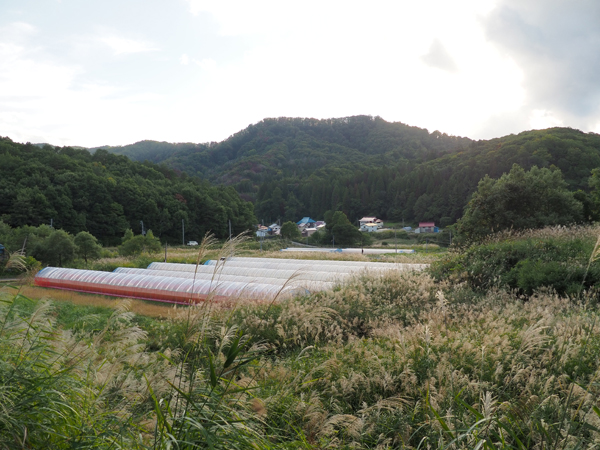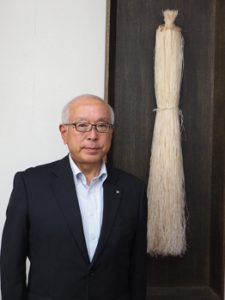Series “Visiting Villages” 38 Showa Village, Fukushima Prefecture: Revitalizing the Community While Preserving Tradition and Culture ①


舟木村長(からむしをバックに)(Mayor Funaki (with caterpillars in the background))
Showa Village, Fukushima Prefecture, is renowned for its traditional craft, ramie weaving. Amid a declining population, the Orihime System was implemented in 1994 to ensure the future of ramie weaving. The Orihime System not only preserves traditional culture, but also plays an important role in facilitating migration and marriage. (Kei Kitajima)
Showa Village is a village in the Aizu region of Fukushima Prefecture, surrounded by mountains over 1,000 meters above sea level. As of September 1, the population was 1,058. Its peak population was 4,810 in 1955, and has been steadily declining ever since. The aging rate exceeds 55%. Mayor Funaki Koichi says, “In Showa Village, about five children are born each year. Around 30 people die. The population is declining at a rate of about 25 people per year. We want to offset this situation with increased social inflows and limit the decline to a gradual one.”
Showa Village is a thriving producer of baby’s breath, boasting the highest summer and autumn shipments in Japan. The plant is also registered as a GI, making it an established brand. In fiscal year 2024, the village is expected to record a record high of 725 million yen, including other flowers. It has now surpassed rice to become the largest industry.
However, with the aging of farmers, there are concerns about a shortage of successors. To address this, the village is promoting initiatives such as the “Baby’s Breath School,” where people can experience training under actual baby’s breath farmers, and is actively welcoming new farmers. These efforts have been successful, with an increasing number of people moving to the village with the aim of becoming baby’s breath farmers, and some years have even seen a shift to social inflow. The village is also focusing on environmentally friendly, high-value-added agriculture, including conducting field trials of organic rice.
“If these efforts are successful and we can produce brand-name rice, young people will want to try their hand at environmentally friendly rice farming, and we can expect even more people to move here,” says Mayor Funaki.
Showa Village is also renowned as the home of ramie weaving, a traditional craft. The production of the raw materials and the manufacturing process for the products have been designated as “Nationally Selected Preserved Techniques,” and the products themselves as “National Traditional Crafts.” Ramie production tools and products have also been designated “Important Tangible Folk Cultural Properties.” Showa Village ramie is also used as the raw material for Echigo-jofu and Ojiya-chijimi, both of Niigata Prefecture, which are registered as UNESCO Intangible Cultural Heritage sites. However, a lack of successors to carry on ramie weaving has been a lingering issue.
As a traditional craft unique to Showa Village, it was somewhat kept secret, but if there are no successors amid the declining population, ramie weaving itself will disappear. To avoid this situation, the “Orihime & Hikoboshi” Karamushi Weaving Experience Program (commonly known as the Orihime System) was launched in 1994.
The Orihime System is a program for women from outside the village to experience and pass on the culture of karmushi weaving while deepening ties with villagers. For 10 months, from June to March, participants stay with karmushi weaving experts in their homes, experiencing the entire process from thread making to weaving. The village covers all expenses and also provides subsidies for living expenses.
Mayor Funaki recalls, “Agriculture experiences are available everywhere, but karmushi weaving can only be experienced in Showa Village, so it initially caused a big stir. We had about 60 applicants for our 10 spots.”
Showa Village is also a region with heavy snowfall, and living conditions are harsher than in urban areas. Since many of the women participating were from urban areas, the villagers apparently expected them to retire soon.
However, almost all of them stayed until the end, and half of them moved to Showa Village.
When asked why they had moved, the women said they were fascinated by the depth of ramie weaving, and that there is a lot of wisdom in the lives of the local elderly people who support ramie weaving, and that they wanted to learn about it up close.
“The villagers were surprised by this, and it reminded them that Showa Village has a culture to be proud of. The Orihime girls brought a breath of fresh air, and this made the villagers take a fresh look at where they were at. For the 32 years since, we have continued the Orihime system as a win-win situation. Not only does it preserve traditional culture, but it has also become a system that plays an important role in encouraging relocation and marriage,” says Mayor Funaki.
The village’s atmosphere has also changed considerably compared to before. It used to have a feudal, closed-off atmosphere, but by accepting people from outside the village, it has become more open and inclusive.
“Now, 20% of the village’s population are immigrants. I see this as another benefit of the Orihime system,” says Mayor Funaki.
An increase in immigrants is good news, but housing remains a challenge. It is difficult to secure housing on limited land, so the current approach is to make effective use of vacant house banks. New Gypsophila farmers in particular want homes with garages, so they prefer vacant farmhouses. For this reason, the village rents vacant houses, renovates them, and rents them out to new farmers. This year, three buildings will be renovated and rented out to new farmers. With the village involved, there are fewer problems, and new farmers can move in with peace of mind.
※Translating Japanese articles into English with AI
